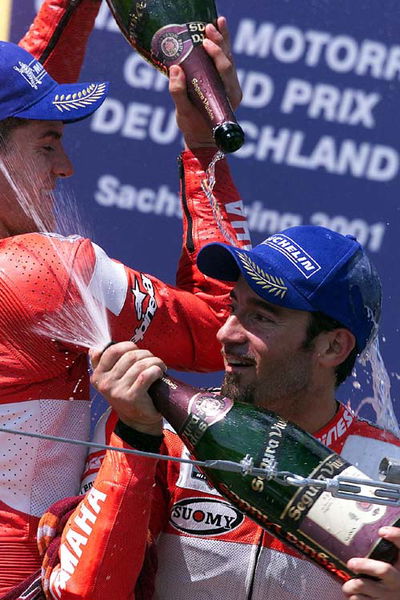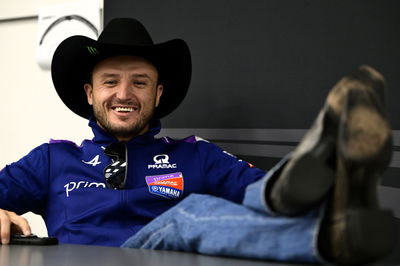The race goes on at Sepang.
This year's 500 World Championship may already have been decided but the action will be as fast and furious as ever at Sepang on Sunday. Marlboro Yamaha Team duo Max Biaggi and Carlos Checa will be racing just the same as they do on every Grand Prix weekend - to win.
Biaggi came within one hundredth of a second of taking victory in last Sunday's stunning Australian GP and is totally committed to going one better at Sepang. Checa had an altogether tougher time Down Under and is determined to make up for that with another podium finish.

This year's 500 World Championship may already have been decided but the action will be as fast and furious as ever at Sepang on Sunday. Marlboro Yamaha Team duo Max Biaggi and Carlos Checa will be racing just the same as they do on every Grand Prix weekend - to win.
Biaggi came within one hundredth of a second of taking victory in last Sunday's stunning Australian GP and is totally committed to going one better at Sepang. Checa had an altogether tougher time Down Under and is determined to make up for that with another podium finish.
This weekend's Malaysian Grand Prix is the country's 11th since the Shah Alam circuit hosted the inaugural Malaysian motorcycle GP in September 1991. The nearby Shah Alam track continued to host the event until 1998 when it moved to Johor before taking up residence at state-of-the-art Sepang in April 1999.
Sunday's GP is the last event of a gruelling run of three back-to-back races that have tested riders and teams to the limit. The GP paddock left Europe at the start of October, raced at Motegi in Japan on October 7 and at Phillip Island in Australia last weekend. GP personnel now get the chance to go home for a brief rest before heading to Brazil for the season ending Rio GP, which happens on Saturday November 3.
The 2001 500 World Championship may have fallen out of his reach but there's still plenty of work for Max Biaggi to do this weekend. The Marlboro Yamaha Team rider needs the best-possible result on Sunday to help him in his efforts to secure second overall in the series. And, of course, there's nothing more he'd like to do than win his fourth race of the season.
"The championship may have gone but I'm still giving 100 per cent to win some more races this year," says Biaggi, who finished a very close second in last Sunday's Australian GP. "I'm just hoping for a little more luck than I usually get at Sepang, for one reason or another I struggled at the last two Malaysian GPs."
However, Biaggi's winter testing form at Sepang suggests that things could be very different this weekend. Before last Christmas he slotted in an astonishingly fast 2m 05.4s lap, over 1.4 seconds inside the track record and the fastest pre-season lap. In last year's race Biaggi finished fourth at Sepang after an entertaining struggle with Garry McCoy (Yamaha) that showed their contrasting styles around the widest track in GP racing. The year before that technical trouble forced him out of the venue's inaugural GP, and he was third in the '98 Malaysian GP at Johor. Before his graduation to the 500 class Biaggi enjoyed an unbeaten run of four 250 victories at Shah Alam, original home of the Malaysian GP.
"I've had some good successes in Malaysia, because I enjoy racing in the heat and it doesn't affect me," he adds. "Of course, you do lose a lot of body weight, so it's important to eat properly and to drink plenty of water, but then we always do that anyway, we care about our health. The big thing is that your motorcycle is also in a good state of health!"
Biaggi and his crew know that Sepang is one of the year's most challenging racetracks, both from rider and machine points of view. "You need a very good package to get a good result there, so I'll be working very hard with my technicians," he continues. "The heat doesn't only make it difficult for us, it also makes life hard for the motorcycle and for the tyres."
While Sepang is a difficult weekend for everyone involved, the efforts of the teams and factories ultimately help produce better motorcycles and better tyres. "The hot and humid conditions make things especially tough for engine performance," says Yamaha's 500 Grand Prix project leader Masahiko Nakajima. "The bikes run very high engine and water temperatures, which makes it a difficult track, but it's an ideal place to investigate our engines to maintain good development."
Next year Yamaha's development priorities will change as GP racing goes four-stroke and the factory's all-new YZR-M1 contests its first World Championship season.
His team-mate Carlos Checa has a remarkable Malaysian Grand Prix record to uphold this weekend. The Marlboro Yamaha Team man has climbed the podium at four of the five 500 Malaysian GPs he's contested, scoring runner-up finishes on the last three occasions.
The affable Spaniard rode his first 500 GP in the country in 1996, his first full season in biking's premier series, finishing third at the old Shah Alam track. The following year he suffered a hiccup in his Malaysian form, finishing sixth at Shah Alam, but he was back on the box in '98, finishing second to five-time 500 king Mick Doohan (Honda) at Johor, near Singapore.
Checa followed that up with second-place finishes at the last two Malaysian World Championship rounds, the first GPs held at the nation's state-of-the-art Sepang facility. On both occasions he finished behind 2000 World Champion Kenny Roberts (Suzuki), last time just 1.8 seconds down on the American, and this weekend he's out to go one better.
"I've always had great results in Malaysia, though I'm not really sure why," says Checa, who battled problems to finish 16th at Phillip Island last weekend. "I guess it may have something to do with the hot conditions. I like it hot because I perform well in the heat, plus it's easier to slide the rear tyre when a track's surface is really hot, and that's how I like to ride. I find it easier when the rear tyre is loose, and controlling wheelspin with the throttle is also a lot of fun. Plus I've tested with Yamaha at Sepang on many occasions over the last couple of years."
Marlboro Yamaha Team manager Geoff Crust and his crew have indeed visited the track several times over the past year, preferring it over other venues, especially for winter testing. "Sepang is a good test track because the weather is okay for testing during the European winter, and the conditions are usually pretty similar whatever time of year you go there," says the Briton. "It's a hot and humid place, so it's tough for both the riders and the machines but the biggest concern is the rain; you can get some big tropical storms in the afternoons, which can mess up qualifying and the race. It's a wide track but there's really only a single fast line, just like at any racetrack, really. That means most of the overtaking is done in the usual places - slipstreaming and braking points."
Checa returns to Malaysia chasing sixth place overall in the 2001 World Championship. He currently lies seventh, 13 points behind fellow YZR500 rider Norick Abe and needs good results at Sepang and at the season-ending Rio GP if he's to catch the Japanese.
"But I won't be the only guy trying really hard at these last two races," he adds. "It's the end of the season so everyone will be riding very hard, trying to show how strong they are. So Sepang will be a very tough race, but I've always got podium finishes there, now I just want to go out and win it!"
The track:
Sepang is one of the longest tracks on the World Championship calendar - only Assen and Suzuka are longer - and boasts the longest-lasting lap in Grand Prix racing, several seconds longer than the Dutch and Japanese venues.
The Malaysian GP venue is also one of the widest racetracks in the world, putting riders and machines to the test with an excellent variety of corners and high-speed straights. Withering heat and humidity are further challenges, not only for riders and machines, but also for technicians and everyone else working in pit lane.
Sepang hosted its first Grand Prix in April 1999 and was an instant hit with riders and teams. The state-of-the-art complex, built adjacent to Kuala Lumpur's brand-new international airport, took circuit and infrastructure design to a new level, combining a fast, safe track layout with ultra-impressive pit, media and corporate facilities.
Max Biaggi finished just off the podium at last year's Malaysian GP but his form during winter testing suggests he will do better than that this weekend. "Sepang is a very nice GP venue, with ultra-modern facilities and pits," says the Marlboro Yamaha Team rider. "The circuit itself is medium fast, very wide and with round corners, through which you can choose many different lines. The heat has quite a big effect on tyres, though I think that will be less of a factor this year, now that everyone runs Michelin's 16.5in rear. Nevertheless, our main focus will be on trying to find enough traction for full-race distance."
Biaggi's crew chief Fiorenzo Fanali agrees that tyres will be a major consideration this weekend. "Last winter we got the bike working very well there, though maybe the most important thing is to find tyres that will give good and constant grip all the way through the race," says the Italian. "Max worked very hard during our Sepang tests to find the right casing and compounds."
Few GP riders know the Sepang racetrack better than Carlos Checa and the Marlboro Yamaha Team man loves the circuit too. "I like the layout because it's quite fast and I think it's wrong that so many new tracks are slow - the bikes get faster and the tracks get slower, we might as well race 125s," he says. "Most of the corners are very, very long, so you're using a lot of lean angle and just gradually opening the throttle, which can make life difficult for the tyres."
Checa's crew chief Mike Webb agrees that Sepang is a challenge for tyres, but adds: "The mechanics also have a tough time. Working on a boiling-hot motorcycle is always tough but in 35-degree heat it's really hard. The conditions are extreme, but we can cope. But I think that the toughest thing is these three races in a row. We've been in three different time zones and three different climates, and neither the riders nor the mechanics get a chance to adjust or get a moment's rest."











